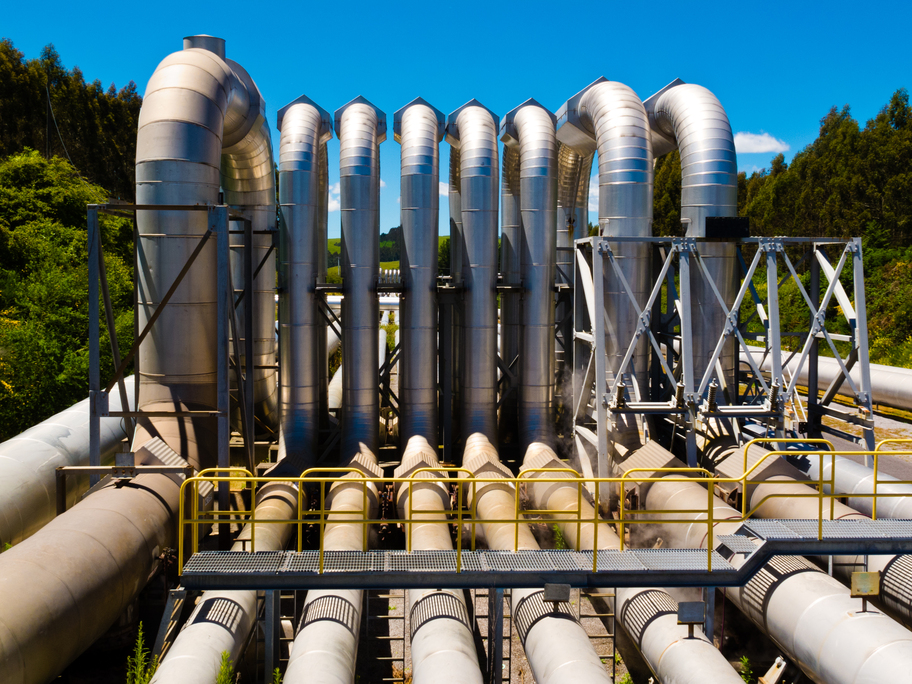Heat Transfer Fluids (HTFs) en la Industria Energética
¿Qué Son los Heat Transfer Fluids (HTFs)?
Los Heat Transfer Fluids (HTFs), fluidos de transferencia térmica o fluidos térmicos, son sustancias utilizadas para transferir calor entre diferentes procesos en sistemas industriales y plantas energéticas. Su función principal es transportar y almacenar el calor desde una fuente de energía, como una planta termosolar, hasta el lugar donde se necesita para su conversión o almacenamiento.
Los HTFs pueden ser líquidos o gases, y su elección depende de varios factores, como la temperatura de operación, las propiedades térmicas, la estabilidad química y la sostenibilidad ambiental. Estos fluidos permiten una transferencia eficiente de calor, lo que contribuye a mejorar la eficiencia energética y reducir las emisiones de carbono.
Definición y Función de los HTFs
Los HTFs son líquidos o gases que se utilizan en sistemas de energía para transportar calor de manera eficiente. Estos fluidos permiten una mayor optimización del proceso de generación de energía renovable y facilitan la conversión de calor en electricidad o energía útil. Son fundamentales en aplicaciones como plantas solares o plantas termoeléctricas.
Principales Características de los HTFs
Las características clave que definen un buen HTF incluyen una alta conductividad térmica, estabilidad a altas temperaturas y una baja viscosidad. Además, deben ser estables químicamente y no degradarse rápidamente bajo condiciones de operación extremas. Esto garantiza que los HTFs mantengan su eficiencia térmica durante periodos prolongados sin perder propiedades críticas que podrían afectar el rendimiento general del sistema energético.
Importancia de los HTFs en la Transferencia de Calor
El uso de HTFs es crucial para mantener la eficiencia de las plantas termosolares y otras instalaciones de energía renovable. Estos fluidos permiten almacenar grandes cantidades de calor a alta temperatura y transferirlo sin pérdidas significativas de energía, lo que es fundamental para optimizar el rendimiento de los sistemas energéticos, especialmente aquellos basados en fuentes renovables intermitentes como la energía solar y eólica.
Tipos de HTFs Principales

Existen diversos tipos de Heat Transfer Fluids (HTFs), cada uno con propiedades únicas que los hacen adecuados para diferentes aplicaciones. En función de su temperatura de trabajo, su composición química y su desempeño térmico, estos fluidos térmicos se pueden clasificar en líquidos, gases y sólidos.
HTFs Líquidos: Aceites Térmicos y Soluciones Líquidas
Los aceites térmicos son uno de los tipos más comunes de HTFs utilizados comúnmente en plantas termosolares, especialmente en las de tecnología cilindro-parabólica. Son ideales para transportar calor a temperaturas de hasta 400°C sin degradarse rápidamente. Además, estos aceites pueden ser utilizados en sistemas de almacenamiento de energía térmica y en procesos industriales que requieren calor constante.
HTFs Gaseosos: Aire y Gases Inertes
Los HTFs gaseosos, como el aire o los gases inertes, se utilizan en sistemas que requieren una transferencia de calor a temperaturas más bajas o donde las propiedades del fluido no deben reaccionar con los materiales del sistema. Estos gases, especialmente en aplicaciones de generación de energía renovable, tienen la ventaja de ser fácilmente disponibles y económicos, aunque no son tan eficientes como los líquidos para almacenar grandes cantidades de calor.
HTFs de Alta Temperatura: Sales Fundidas y Otros Materiales
Las sales fundidas son HTFs avanzados que se utilizan en aplicaciones de almacenamiento térmico de energía a gran escala. Son capaces de operar a temperaturas extremadamente altas (más de 500°C) sin perder eficiencia. Las sales fundidas tienen una alta capacidad para almacenar y liberar calor, lo que las hace ideales para plantas termosolares (especialmente utilizadas en plantas de tecnología de torre solar) y centrales de energía renovable que operan de manera continua, incluso cuando no hay luz solar directa.
Comparación de Rendimiento entre Diferentes Tipos de HTFs
La elección del tipo de HTF depende de varios factores, como la temperatura operativa, la eficiencia térmica, el costo y la sostenibilidad. Los aceites térmicos y las sales fundidas suelen ser más eficientes a altas temperaturas y en aplicaciones de almacenamiento de energía térmica renovable. Por otro lado, los gases pueden ser útiles en situaciones donde se necesita un fluido menos costoso y fácil de manejar, aunque con una eficiencia térmica más baja.
Aplicaciones de los Heat Transfer Fluids (HTFs)

Los Heat Transfer Fluids (HTFs) desempeñan un papel esencial en una amplia variedad de aplicaciones industriales y energéticas. Su capacidad para transferir calor de manera eficiente y operar en un rango amplio de temperaturas los convierte en componentes clave en la generación de energía térmica y en muchos procesos industriales. A continuación, se detallan algunas de las principales aplicaciones de los HTFs en sectores como la energía, la industria y el sector alimentario y farmacéutico.
Uso en la Generación de Energía Térmica: Plantas Termosolares y Termoeléctricas
Los fluidos térmicos son fundamentales en la generación de energía térmica, especialmente en plantas termosolares y termoeléctricas. En plantas termosolares, los HTFs como las sales fundidas o los aceites térmicos permiten almacenar y transportar calor proveniente del sol, que luego se utiliza para generar electricidad. Estos fluidos térmicos permiten mantener una alta eficiencia operativa, incluso cuando no hay radiación solar directa. En las centrales termoeléctricas, los HTFs también permiten transferir calor desde una fuente caliente a un generador para producir electricidad de manera eficiente.
Las plantas termosolares (especialmente las de torre), por ejemplo, emplean sales fundidas como fluido térmico debido a su alta capacidad para almacenar calor a temperaturas superiores a 500°C. Esto permite que estas plantas sigan operando de manera continua, incluso durante la noche o en días nublados, lo que las hace ideales para la generación de energía renovable a gran escala.
Aplicaciones Industriales: Procesos de Alta Temperatura y Cogeneración
En la industria, los HTFs se utilizan en una variedad de procesos que requieren altas temperaturas, como la fabricación de acero, vidrio, cemento, productos químicos y en la industria de alimentos. Los aceites térmicos y sales fundidas son utilizados para transferir calor a los hornos y otras unidades térmicas. Estos fluidos garantizan que las operaciones industriales se mantengan a la temperatura óptima para la producción eficiente de estos materiales.
Además, los fluidos térmicos son cruciales en los sistemas de cogeneración, que son capaces de generar tanto electricidad como calor útil a partir de una sola fuente de energía. La cogeneración es un proceso muy eficiente que reduce el consumo de energía y las emisiones de CO2, y el HTF permite transferir el calor de manera eficaz en estas instalaciones.
Enfriamiento de Equipos y Máquinas en la Industria
Además de la generación de energía, los HTFs también tienen aplicaciones críticas en el enfriamiento de equipos y máquinas en diversas industrias. En sectores como la electrónica, automotriz, petroquímico y de telecomunicaciones, el control de temperatura es esencial para evitar el sobrecalentamiento de equipos clave. Los fluidos de transferencia térmica como el agua o los aceites térmicos se utilizan para absorber el calor de los componentes, lo que ayuda a mantener la maquinaria operando a temperaturas seguras.
En el caso de las centrales eléctricas, por ejemplo, los HTFs refrigerantes se utilizan para enfriar las turbinas y otros componentes críticos. Esto no solo mejora la fiabilidad y la vida útil de los equipos, sino que también contribuye a una mayor eficiencia operativa.
Uso en la Industria de Alimentos y Farmacéutica
Los fluidos térmicos también tienen aplicaciones importantes en sectores como la industria de alimentos y la farmacéutica, donde se requieren condiciones de temperatura controladas para garantizar la seguridad y calidad de los productos. En la industria alimentaria, HTFs como los aceites térmicos se utilizan en procesos como la pasteurización, la esterilización y la cocción de alimentos a gran escala. El uso de estos fluidos permite un control preciso de la temperatura, lo que ayuda a preservar los nutrientes y las características organolépticas de los productos.
En la industria farmacéutica, los fluidos térmicos son fundamentales en los procesos de fabricación de productos como medicamentos, vacunas y dispositivos médicos. En estos casos, el control de la temperatura es crucial para mantener la calidad de los productos durante la producción y almacenamiento, especialmente en el caso de las vacunas, que requieren condiciones térmicas específicas para su conservación.
Degradación de los Heat Transfer Fluids (HTFs)

La degradación de los fluidos térmicos es un fenómeno común que puede afectar su rendimiento y vida útil. Fluidos como los aceites térmicos, las sales fundidas o el agua, son fluidos esenciales para una variedad de aplicaciones industriales y energéticas, y su eficiencia depende en gran medida de su capacidad para mantener sus propiedades térmicas a lo largo del tiempo. La degradación de estos fluidos puede comprometer tanto la seguridad como la eficiencia de los sistemas que los utilizan, por lo que es fundamental entender los factores que influyen en su deterioro y tomar las medidas adecuadas para prevenirlo.
Factores que Afectan la Vida Útil de los HTFs
La vida útil de los HTFs está influenciada por varios factores, tales como la temperatura, la exposición al aire, la humedad y la presión. Uno de los principales factores es la temperatura de operación, ya que un exceso de calor ya que acelera la descomposición química del HTF, provocando la pérdida de sus propiedades termodinámicas. Además, los HTFs pueden experimentar cambios en su viscosidad y capacidad de transferencia de calor a medida que se descomponen. La oxidación es otro factor importante, ya que la exposición al oxígeno puede generar compuestos indeseables que deterioran el fluido. Por lo tanto, mantener una temperatura controlada y minimizar la exposición al aire son medidas clave para prolongar la vida útil de estos fluidos.
Signos de Degradación de HTFs: Cambio de Propiedades y Contaminación
Los signos de degradación del HTF pueden ser observados a través de varios cambios en sus propiedades físicas y químicas. Uno de los primeros indicadores de que un fluido está en proceso de deterioro es el aumento de la viscosidad, lo que dificulta su circulación y transferencia de calor. Otro signo común es la contaminación con partículas, agua o compuestos ácidos, lo que puede alterar la capacidad del fluido para desempeñar su función correctamente. También es posible observar un cambio en el color del fluido, especialmente en aceites térmicos, que tienden a oscurecerse a medida que se oxidan. Además, la corrosión de los equipos puede ser un síntoma de que el HTF utilizado contienen contaminantes perjudiciales.
Mantenimiento y Reemplazo de HTFs: Mejores Prácticas
El mantenimiento adecuado de los fluidos térmicos es esencial para garantizar su rendimiento a largo plazo y evitar problemas relacionados con la degradación. Entre las mejores prácticas para mantener los HTFs en buen estado se incluyen el monitoreo regular de sus propiedades físicas y químicas, como la viscosidad, la acidez y el contenido de agua. Los sistemas de filtración deben ser revisados y reemplazados periódicamente para eliminar las impurezas. Además, es recomendable realizar cambios de fluido programados basados en las recomendaciones del fabricante, lo que asegura que el fluido mantenga su rendimiento óptimo. El reemplazo del fluido debe realizarse con fluido de calidad compatible con el sistema, para evitar la contaminación y garantizar la eficiencia térmica.
Efectos de la Degradación del HTF en la Eficiencia Energética
La degradación de los HTFs puede tener un impacto significativo en la eficiencia energética de los sistemas que los utilizan. A medida que el fluido pierde sus propiedades térmicas, la capacidad de transferencia de calor disminuye, lo que provoca una mayor resistencia térmica y la necesidad de consumir más energía para alcanzar las temperaturas deseadas. Esto puede resultar en pérdidas de eficiencia y un aumento en el consumo de energía. En sistemas de almacenamiento de energía térmica, por ejemplo, la degradación del fluido de transferencia térmica puede reducir la cantidad de energía que se puede almacenar o recuperar, afectando la rentabilidad y el rendimiento global del sistema. Además, los costos operativos aumentan a medida que se requieren más recursos para mantener la misma eficiencia en el proceso.
En resumen, la degradación del HTF es un factor importante que debe ser cuidadosamente gestionado en aplicaciones industriales y energéticas para garantizar el rendimiento y la seguridad de los sistemas. La comprensión de los factores que afectan la vida útil de los HTFs, la identificación temprana de los signos de degradación y la implementación de buenas prácticas de mantenimiento son fundamentales para minimizar los efectos negativos de este fenómeno y maximizar la eficiencia energética.
¿Cómo Elegir los HTFs Adecuados para un Proyecto Energético?

Seleccionar el HTF adecuado para un proyecto energético es crucial para asegurar un rendimiento óptimo y una alta eficiencia a largo plazo. La elección correcta de un HTF influye directamente en la eficiencia energética, la durabilidad de los sistemas y el impacto ambiental. La utilización de un fluido de transferencia de calor inapropiado puede generar pérdidas de rendimiento, aumentar los costos operativos y afectar la sostenibilidad de la instalación. Por lo tanto, es fundamental entender las características de cada tipo de HTF y cómo se ajustan a las necesidades específicas del proyecto.
Impacto en la Eficiencia Energética y el Rendimiento
El tipo de HTF seleccionado tiene un impacto directo en la eficiencia energética de los sistemas que utilizan transferencia de calor. Un fluido de alta calidad que se adapta a las condiciones operativas del sistema asegura una mejor transferencia de calor, reduciendo las pérdidas térmicas y mejorando la eficiencia general. Al elegir el HTF adecuado, se optimiza el rendimiento de las instalaciones energéticas, lo que se traduce en un consumo de energía más bajo, menores costos operativos y una mayor capacidad de almacenamiento o recuperación de energía. En aplicaciones como plantas termosolares o de almacenamiento térmico de energía, un HTF eficiente garantiza un rendimiento más alto, lo que resulta en una mejor viabilidad económica y mayor capacidad de generación de energía.
Consideraciones Económicas y Ambientales al Seleccionar HTFs
La elección de un HTF adecuado no solo debe basarse en la eficiencia térmica, sino también en las consideraciones económicas y ambientales del proyecto. Desde una perspectiva económica, es esencial elegir un fluido que sea económicamente viable para el proyecto, tanto en términos de costo inicial como de mantenimiento a largo plazo. Además, algunos HTFs pueden tener un mayor impacto ambiental, ya sea por su toxicidad, emisiones o desperdicio de recursos en su ciclo de vida. Por tanto, es crucial evaluar el impacto ambiental del fluido y considerar alternativas que sean más sostenibles y que ayuden a reducir la huella de carbono. Los HTFs renovables o aquellos con menor impacto ambiental son opciones ideales para proyectos orientados hacia la sostenibilidad.
Consejos para Elegir el HTF Ideal para tu Aplicación
Al elegir el HTF adecuado, se deben tener en cuenta varias consideraciones clave. Primero, evalúa las condiciones operativas del sistema, como la temperatura máxima, la presión de trabajo y las características térmicas requeridas para el proyecto. Asegúrate de que el HTF seleccionado tenga la capacidad térmica y estabilidad térmica necesarias para soportar esas condiciones sin comprometer su rendimiento. Además, es importante considerar aspectos como la viscosidad, la punto de ebullición, la compatibilidad con materiales del sistema y la facilidad de mantenimiento. No olvides investigar sobre las características de seguridad y la facilidad de manejo del fluido. También es recomendable consultar estudios de caso y experiencias de otros proyectos similares.
Casos de Éxito en el Uso de HTFs
Existen múltiples casos de éxito en los que la selección adecuada de un HTF ha sido clave para el éxito de proyectos energéticos. En el ámbito de las plantas termosolares, el uso de sales fundidas ha permitido una alta capacidad de almacenamiento de energía térmica y un rendimiento eficiente en la generación de electricidad. De igual manera, en las plantas de biomasa y centrales de ciclo combinado, el uso de aceites térmicos de alta calidad ha demostrado un rendimiento eficiente y sostenibilidad en sus operaciones. Estos ejemplos destacan la importancia de elegir el HTF adecuado para maximizar la eficiencia energética y garantizar un rendimiento continuo de las instalaciones.
En resumen, seleccionar el HTF adecuado para tu proyecto energético es una decisión crítica que influye en todos los aspectos del funcionamiento y éxito de la instalación. Considerando factores como la eficiencia energética, los costos, las implicaciones ambientales y las condiciones operativas, podrás garantizar una solución óptima que favorezca tanto la rentabilidad como la sostenibilidad.
Renewable
Power Onwards
Ingenieros con más de 20 años de experiencia
